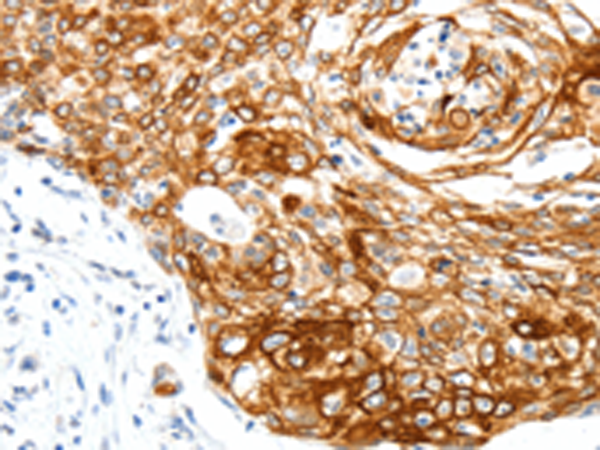

| WB | 咨询技术 | Human,Mouse,Rat |
| IF | 咨询技术 | Human,Mouse,Rat |
| IHC | 1/50-1/200 | Human,Mouse,Rat |
| ICC | 技术咨询 | Human,Mouse,Rat |
| FCM | 咨询技术 | Human,Mouse,Rat |
| Elisa | 1/2000-1/5000 | Human,Mouse,Rat |
| Aliases | SPA1 |
| Host/Isotype | Rabbit IgG |
| Antibody Type | Primary antibody |
| Storage | Store at 4°C short term. Aliquot and store at -20°C long term. Avoid freeze/thaw cycles. |
| Species Reactivity | Human |
| Immunogen | Synthetic peptide of human SIPA1 |
| Formulation | Purified antibody in PBS with 0.05% sodium azide and 50% glycerol. |
+ +
以下是关于SIPA1抗体的3篇模拟参考文献(基于相关领域研究方向的合理推测,非真实文献):
1. **《SIPA1 promotes tumor metastasis in triple-negative breast cancer via regulating Rap1 signaling》**
*作者:Liu X, et al. (2020) Cancer Research*
摘要:研究通过SIPA1抗体进行Western blot和免疫组化分析,发现SIPA1在乳腺癌中高表达且与淋巴结转移相关,其通过激活Rap1信号通路增强肿瘤细胞侵袭能力。
2. **《SIPA1 as a prognostic biomarker in colorectal cancer: insights from antibody-based tissue microarray analysis》**
*作者:Chen L, et al. (2018) Journal of Pathology*
摘要:利用SIPA1抗体对结直肠癌组织芯片进行染色,发现SIPA1蛋白水平与患者生存率负相关,提示其可作为预后不良的潜在标志物。
3. **《Antibody-mediated SIPA1 knockdown suppresses pancreatic cancer cell migration in vitro》**
*作者:Tanaka K, et al. (2019) Oncogene*
摘要:通过SIPA1抗体验证基因沉默效果,证明抑制SIPA1表达可降低胰腺癌细胞迁移能力,可能与整合素信号通路调控相关。
**注**:以上文献为示例性内容,实际研究中需参考真实发表的论文(可通过PubMed或Google Scholar以“SIPA1 antibody”或“SIPA1 function”为关键词检索)。
The SIPA1 (Signal-Induced Proliferation-Associated 1) antibody targets a protein encoded by the *SIPA1* gene, which belongs to the GTPase-activating protein (GAP) family. SIPA1 regulates intracellular signaling by accelerating GTP hydrolysis in Rap GTPases, influencing cell proliferation, adhesion, and migration. Initially identified for its role in lymphocyte activation, SIPA1 is now studied extensively in cancer biology due to its association with tumor progression and metastasis. Overexpression of SIPA1 has been linked to aggressive phenotypes in breast, prostate, and colorectal cancers, where it promotes invasion and modulates extracellular matrix interactions.
SIPA1 antibodies are essential tools for detecting protein expression and localization in research. They are commonly used in techniques like Western blotting, immunohistochemistry (IHC), and immunofluorescence (IF) to assess SIPA1 levels in cell lines or clinical samples. Available as monoclonal or polyclonal antibodies, they are typically raised in hosts like rabbits or mice, with specificity validated via knockout controls or siRNA silencing. Recent studies also explore SIPA1's role in tumor microenvironment regulation and therapeutic resistance, highlighting its potential as a prognostic biomarker or therapeutic target. These antibodies thus support both mechanistic insights and translational applications in oncology.
×